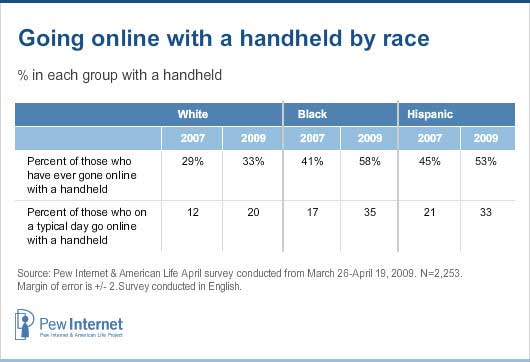More than half of Americans—56%—report having used wireless means to gain online access, according to a Pew Research report that examines how Americans are accessing the Internet by wireless means using a range of devices—laptops, handheld devices (including cell phones and smartphones), gaming consoles, and e-book readers.
Conducted by the Pew Research Center's Internet & American Life Project, an April 2009 survey asked US respondents whether they had used a variety of devices. Wireless access via laptop and mobile devices account for most US wireless access, as 51% of Americans have gotten online using either of these two methods:
- 39% say they have used a laptop computer to go online wirelessly—the most prevalent means of wireless access.
- 32% say they have gotten online with a mobile device—a cell phone or other handheld device—to check email, access the Internet for information, or send instant messages.
- Some 19% of Americans say they have used laptops as well as handheld device for online access.

Use of the Internet on mobile devices has grown sharply from the end of 2007 to the beginning of 2009.
- In December 2007, 24% of Americans said they had accessed the Internet via their mobile device; by April 2009, 32% of Americans said so.
- In December 2007, 11% of Americans said they had "yesterday" accessed the Internet on their mobile; by April 2009, 19% of Americans said so.
African Americans are the most active users of the mobile Internet—and their use of it is also the fastest-growing. When mobile access is taken into account, the digital divide between African Americans and white Americans diminishes:
- 48% of Africans Americans have used their mobile device to access the Internet for information, emailing, or instant messaging; that's 50% higher than the national average of 32%.
- 29% of African Americans use the Internet on their handheld on an average day, also nearly 50% higher than the national average of 19%.
- Compared with 2007, when 12% of African Americans used the Internet on their mobile on the average day, their use of the mobile Internet is up 141%.

The high level of internet access among African Americans on mobile devices helps offset lower use levels of "traditional" online-access tools—desktop computers, laptops and home broadband connections:
- White Americans are more likely than African Americans (59% vs. 45%) to go online using a computer on a typical day.
- When mobile devices are included in the mix, the gap is cut in half: 61% of whites go online on the average day when mobile access is included, while 54% of African Americans do.
- Across a range of digital activities—some done online typically using a computer and others (non-voice data activities) on a mobile device—African American and white Americans, on average, engage in the same number of activities.
In 2007 and 2009, respondents were asked about 10 non-voice data activities on cell phones: sending or receiving text messages, taking a picture, playing a game, checking email, accessing the Internet, recording video, instant messaging, playing music, getting maps or directions, or watching video:
- In 2009, 69% of all adult Americans said they had ever done at least one of the 10 activities, versus 58% who said so in late 2007.
- In 2009, 44% of all adult Americans said they had done at least one of the non-voice data activities on a typical day, up from 32% in 2007.
Other access devices—iPods, game consoles, and e-books—play a relatively small role in people's wireless online habits:
- 45% of adults have an iPod or MP3 player; only 5% of adults have used such a device to go online.
- 41% of adults have game consoles; 9% of adults have used it to go online.
- 14% of adults say they have a personal digital assistant; 7% of adults have used a PDA to go online.
- 2% of adults say they own an e-book reader; just 1% of adults have used a reader to access the Internet.
In all, 17% of Americans have used one these four devices for wireless Internet access. If these users weren't counted among those accessing the Internet wirelessly, 51% of Americans would be wireless Internet users rather than 56%.
Mobile users were asked about the importance of how they get information or communicate with others while away from home or work:
- 50% say it is very important to them to have mobile access to stay in touch with others.
- 46% say mobile access is very important for getting online information on the go.
- 17% say mobile access is very important to them so they can share or post content online while away from home or work.
About the findings: The April 2009 Pew Internet survey interviewed 2,253 adult Americans, including 561 who were interviewed on their cell phone. The margin of error in the survey is plus or minus two percentage points for results based on the entire sample. The survey contained 1,687 Internet users and 1,818 respondents who are cell phone users. The findings from December 2007, used in comparisons with the April 2009 survey, come from a survey with cell phone numbers included in the sample.



